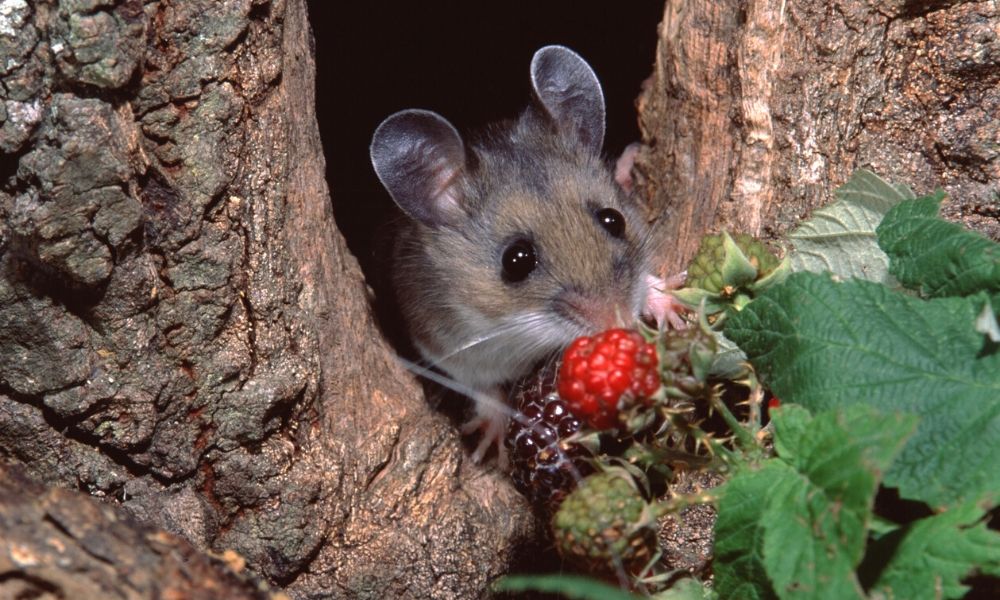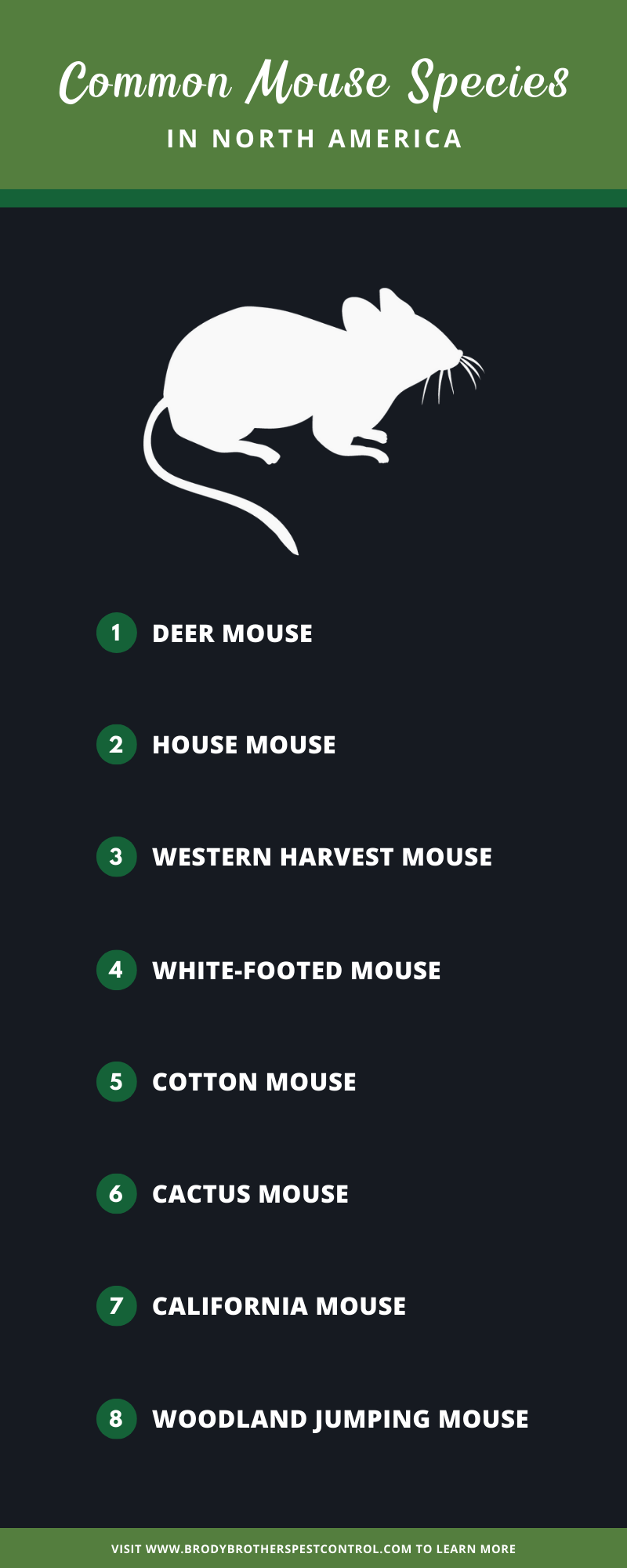
Mice are rodents known for their small appearance, their ability to frighten people, and spreading harmful diseases.
Depending on where you are in North America, you may encounter a different mouse species that you might not be familiar with. Many mice species have altered appearances and abilities based on the environment they live in so that they can survive, just like many other animals.
Discover the common mouse species in North America, and learn about their different habitats, appearances, diets, and more important information.
1. Deer Mouse
Peromyscus maniculatus are commonly referred to as deer mice, and they’re one of the most prevalent rodent species found all over the continent. You can identify deer mice by their brown back and white belly. Deer mice also have large eyes and ears. Like many mice, they’re fairly small—they usually reach approximately five to eight inches in length, which includes their tail. A deer mice’s diet consists of seeds, grains, berries, nuts, spiders, and caterpillars. Some diseases deer mice carry include Hantavirus and Lyme disease bacteria. Cats, snakes, foxes, and birds of prey are all threats to deer mice.
2. House Mouse
Another widely common mouse species found everywhere in the U.S. are house mice. You can easily identify a house mouse by its dark grey fur and it’s much smaller appearance compared to deer mice. A house mouse will consume seeds, crumbs, and anything you leave on your table, which is why its vital that you clean up after yourself to keep them away. House mice are known to contaminate food in addition to spreading fleas, lice, mites, and ticks throughout your home. Like deer mice, house mice must also worry about snakes, cats, foxes, and birds of prey.
3. Western Harvest Mouse
The reithrodontomys megalotis, otherwise known as the western harvest mouse, is commonly found on the western side of the United States and in central Mexico. A western harvest mouse resides in open areas like marshes, meadows, and grasslands. This mouse species can also exist in deserts, dunes, and shrublands. A western harvest mouse sports gray and brownish fur with a white and gray belly. Western harvest mice also have much longer tails, which can get as long as their body. This mouse species is just slightly smaller in size than deer mice, and it ranges from four to six inches in length. Western harvest mice have natural predators such as snakes, owls, hawks, scorpions, and coyotes.
4. White-Footed Mouse
Peromyscus leucopus, also known as white-footed mice or field mice live mostly around the eastern United States, up in Nova Scotia, Canada, and in eastern and southern Mexico. However, the white-footed mouse doesn’t live south of Virginia on the east coast or west of the Rocky Mountains and the Sierra Madre. Not unlike many mice species, a white-footed mouse has a brownish to reddish back fur, a white stomach, and they have white feet, hence their namesake. The white-footed mouse can be as small as five inches long to as big as eight. A white-footed mouse will consume insets, leaves, nuts, fruit, flowers, grains, and more to survive. White-footed mice fear the same types of predators most other species do, which includes various birds, snakes, and foxes, but they must also deal with weasels.
5. Cotton Mouse
Peromyscus gossypinus, also called cotton mice, scurry around the southeastern part of the United States in habitats such as swamplands, dunes, forests, and grasslands. A cotton mouse’s appearance consists of dark brown fur and a short tail, which differs from most mice species. A cotton mouse size is similar to a white-footed mouse; it’ll grow around five to eight inches. Cotton mice also eat the same foods as others such as insects, fungus, seeds, and fruit. They face the same predators as other mice species, but cotton mice must also contend with bobcats and striped skunks.
6. Cactus Mouse
The cactus mouse, or the peromyscus eremicus, lives in desert environments with cliffs and rocky foothills found in the western part of the United States. A cactus mouse’s fur can range from dark to light with gray, black, and even yellowish colors. Cactus mice are omnivores, which means they feast on all different kinds of plants and animals. Given their limited food selection in their environment, they will usually resort to seeds, and they can survive without a lot of water when temperatures rise. The desert comes with unique predators, such as rattlesnakes, owls, and foxes, they have to avoid.
7. California Mouse
Peromyscus californicus earns its common name, California mouse, because you can find them across the golden state. California mice are quite large for mice species in North America, and they fluctuate in size from eight to 11 inches in length. You can identify a California mouse by its multiple fur colors like gray, yellow brown, and it’s common white belly and feet. California mice are herbivores, frugivores, and granivores, so their diet mostly consists of nuts, fruits, plants, and animal parts.
8. Woodland Jumping Mouse
The final mouse species in North America lives around the northeastern portion of the continent, and it’s known as the woodland jumping mouse (napaeozapus insignis). The woodland jumping mouse may be the most strange-looking mouse species on this list with its fur composed of yellow, orange, and black hairs. Woodland jumping mice are omnivores, and they have to worry about a wide range of predators from cats to wolves. Woodland jumping mice get their name from their ability to jump away from these predators, but one can always jump on a human.
The two mice species you must worry about in the Baltimore area are deer and house mice. These two types mice will enter your home more often than any other mice species, and they can potentially cause infestations, damage, and will spread diseases. Since winter and the colder weather is beginning to take shape, these mice will seek shelter in your home. Many people tend to deal with mice by setting up mousetraps, but this tactic is not effective. Instead, contact Brody Brothers for professional pest control services. We can perform a proper inspection and keep mice away year-round with our proven methods.


